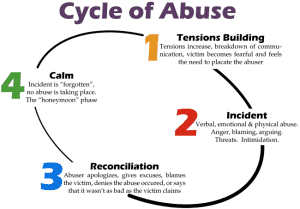
![]()
Countless United States citizens are victimized by domestic violence on a daily basis. It can be easy to blame the abusers and move on, but to tackle the issue in a way that ends cycles of abuse has been an insurmountable challenge.
Psychologist Lenore Walker observed that many violent relationships follow a recognizable and predictable pattern. The entire domestic violence cycle differs from relationship to relationship. It may happen in one day, or in some cases, it can weeks, months, or even years.
The domestic violence cycle has three major parts; the first phase is the tension building stage, at this stage tension is likely to build over common domestic matters like the couple’s children, money, and job.
This phase builds up to form the second stage, which is the acute battering episode.
At this stage, what is referred to as a tension peak and physical violence is likely to be experienced. It is usually triggered by an external event or factor.
Finally, the third phase is the honeymoon phase. Initially, the abuser is ashamed of his or her deeds, and he or she will often express remorse while they try to blame the event on the other partner.
Many abuse victims are convinced by their abusers that the abuse is no longer an issue and that the victim should give the relationship a second, third, or an endless number of chances.
Over the years, much of the public has become aware of how difficult it is to break free from this cycle, and that a lot of men and women are struggling with it on a daily basis.
The following tips are designed to help domestic violence victims and perpetrators recognize abusive behavior, respond, report it, and re-channel anger.
- You don’t have to control everything. Avoid behaviors that are likely to control or demean other parties.
- When you get angry, (which is normal) be it with your children or your partner, respond without accidentally or intentionally humiliating or hurting other parties. Formulate a non-violent way of responding to situations that get you riled up.
- If your friend or coworker expresses that they are in an abusive relationship, offer him or her support by taking over the situation and making appropriate decisions. Call the police for them and take action to help keep them safe.
- Develop a habit of calling the police if you hear or suspect violence in progress.
- If you’re in an abusive relationship, try reaching out to your neighbors. Talk to them, ask advice from them. You never know, perhaps they will have the advice and support that can help you move on.
- Showing support for violent victims can work miracles. By attending public events and talking about this issue, you may convince a victim that you are trustworthy, and they may open up to you about their abuse.
- Finally, you can volunteer and donate your time to crisis programs in the community. There are various volunteering activities ranging from directly working with victims to helping perpetrators rehabilitate.
If you or your loved one are suffering from domestic abuse, contact your local abuse hotline and get help. You don’t deserve to be beaten. Get help today and move on with your life.
